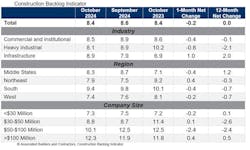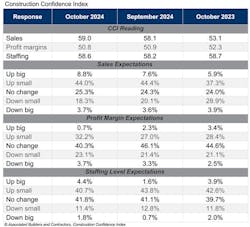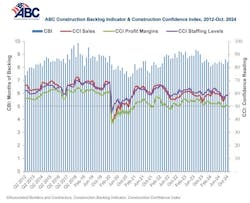ABC: Backlogs Slipped in October
PRESS RELEASE
WASHINGTON, Nov. 12 — Associated Builders and Contractors (ABC) reported today that its Construction Backlog Indicator fell to 8.4 months in October, according to a survey of its member contractors conducted Oct. 21 to Nov. 4. The reading is unchanged from October 2023.
View the full Construction Backlog Indicator and Construction Confidence Index data series.
Backlog fell in every region except for the Northeast in October, reversing the previous month’s trend in which every region except for the Northeast saw an increase in backlog. Only the Middle States have longer backlog than one year ago.
ABC’s Construction Confidence Index readings for sales and staffing levels improved in October, while the reading for profit margins inched slightly lower. The readings for all three components are above the threshold of 50, indicating expectations for growth over the next six months.
“While backlog declined in October, it remains at a healthy level and has been remarkably stable over the past year," said ABC Chief Economist Anirban Basu. “Like much of the economy, the construction industry remained in some semblance of a holding pattern in October as project owners continue to wait for election outcomes and for interest rates to decline further. Despite this wait-and-see attitude, contractors remain upbeat about the next two quarters. Approximately 53% of ABC members expect their sales to increase over the next six months, while just 22% expect them to decline.”
Note: The reference months for the Construction Backlog Indicator and Construction Confidence Index data series were revised on May 12, 2020, to better reflect the survey period. CBI quantifies the previous month's work under contract based on the latest financials available, while CCI measures contractors' outlook for the next six months. View the methodology for both indicators.



